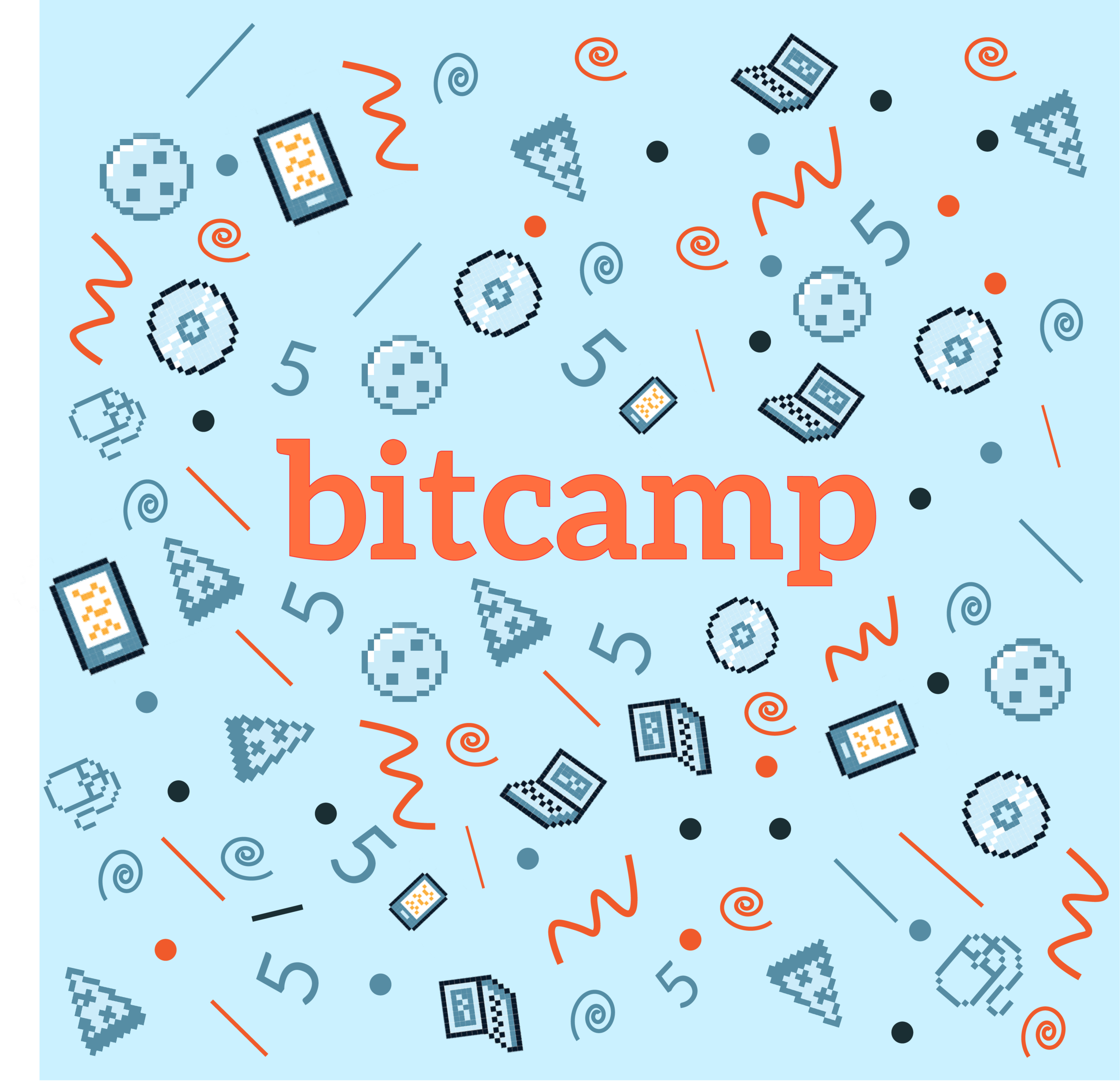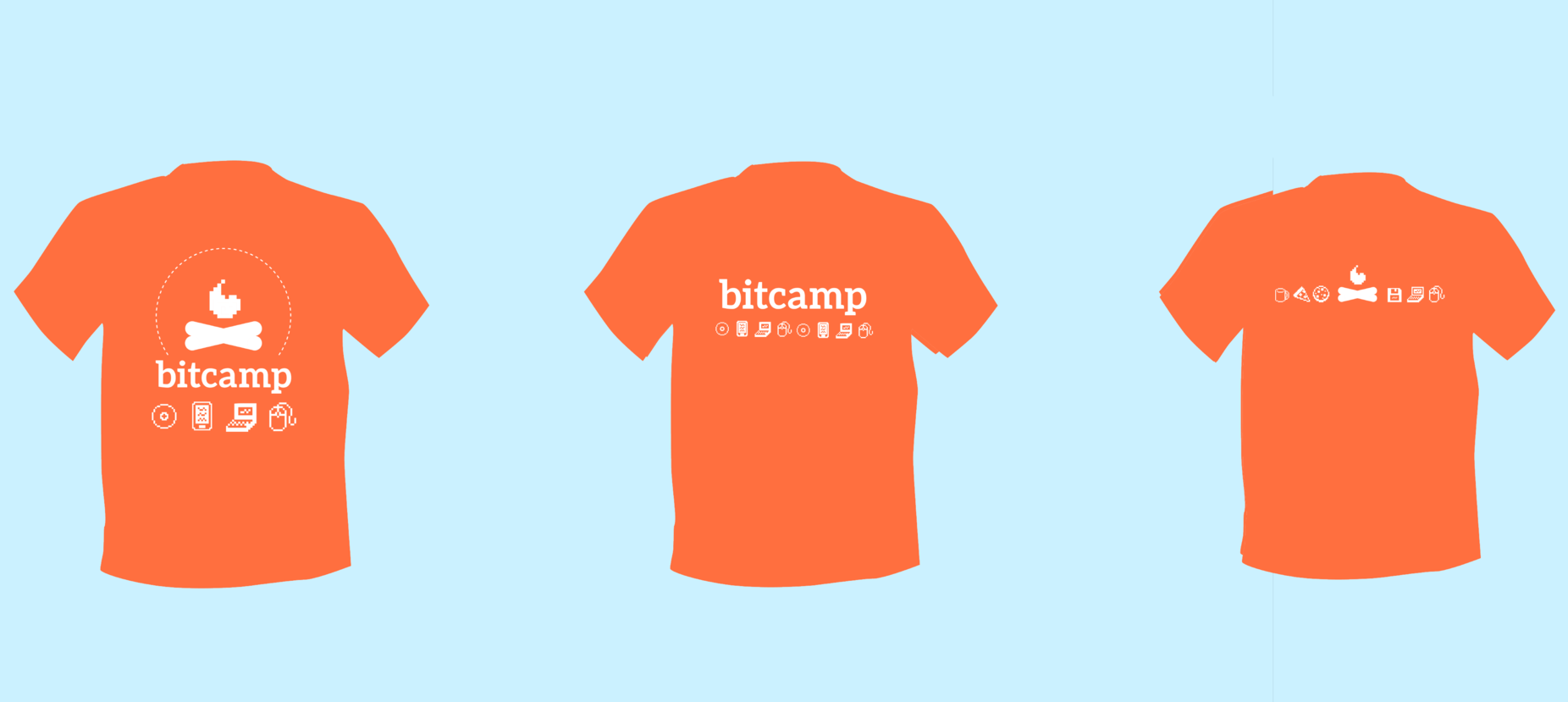BITCAMP - 2018
GRAPHIC DESIGN | BRANDING | EVENT OPERATIONS | EXPERIENCE DESIGN
TIMELINE: 6 MONTHS
I was brought onto Bitcamp, University of Maryland's premiere spring hackathon, as part of the design team and eventually as the lead experience coordinator for an effort known as Design Trail.
*Due to the multidisciplinary nature of this project, it is structured differently than other Product + UX case studies.
Photo of hackers gathered around the campfire at Bitcamp 2018: University of Maryland's premier spring hackathon.
My contributions to Bitcamp 2018 consisted of two different design disciplines for two very different design challenges:
Branding + Visual Design - how might we incorporate confetti and pixel elements into Bitcamp's branding celebrating its fifth year without compromising the current brand identity?
Service Design - how might we incorporate a design component into Bitcamp 2018 to cater to the emerging importance of design in the tech space?
BRANDING + VISUAL DESIGN
How might we incorporate confetti and pixel elements into Bitcamp's branding celebrating its fifth year without compromising the current brand identity?
Branding Guidelines:
Color Palette
The colors of Bitcamp are reminiscent of being at camp with lots of warm tones and a few cooler tones to contrast with the red and orange hue as well as mimic the outdoor sky.
Logo
The fire logo was a classic symbol of the type of hackathon Bitcamp was: friendly and fun.
Font
Bitcamp primarily use Avenir for content and Aleo for the logo type and headers. The breakdown can be seen as:
Main Font: Aleo
http://fontfabric.com/aleo-free-font/
Line Height: 1.45
Logotype
bold, lowercase
H1
64px, light, uppercase
H2
40px, bold, title case
H3
27px, regular, sentence case
Body
18px, regular
Alternative (for web + publications)
Font: Avenir <- (Avenir Black for Colorwar)
H3
27px, bold, uppercase
Body
12px, regular, sentence case
1. HACKER T SHIRTS
I was given the opportunity to help design both the hacker and COLORWAR shirts for the 2018 weekend. Bitcamp has over 1200 hackers who come to build and create projects over the weekend so the T Shirt design had the opportunity to be very high impact for Bitcamp's outward brand. Our initial designs used the classic Bitcamp orange with various white pixels as graphic elements.
The first few versions of the hacker shirts. We wanted to see how we could incorporate the new pixel icons created in celebration of the fifth year.
But we looked at previous Bitcamp hacker shirts and they tended to be rather simple with either solely the logo or the logo type as the main graphic element of the shirt. We decided to keep the shirt design simple but timeless. We decided to make the color a bold red as it was part of Bitcamp's color palette but had not yet been used for hackers' shirts.
Final design for hacker shirts.
During the weekend, we saw many hackers wearing our shirts. Some even wore it while giving their demos to sponsors!
Hackers wearing their new hacker shirts during demo day!
2. COLORWAR T SHIRTS
COLORWAR is a one hour live creative competition for more artistically inclined hackers. Before and during the weekend, hackers submit a creative piece and are then slimmed down to five finalists who compete in live drawing challenges for prizes. COLORWAR shirts tend to be in limited supply because they are meant to be worn by judges, competitors, and COLORWAR masters of ceremonies who narrate the event. Usually around 25 shirts are printed so there was more opportunity to experiment with the design.
COLORWAR shirt design
I decided to incorporate the confetti and pixel graphic elements into the COLORWAR logo (two swords crossing). I also decided to make the COLORWAR shirts orange since the hacker shirts were red and the organizer shirts were blue. It made a nice contrast and was still within Bitcamp's color palette.
The masters of ceremony wearing the COLORWAR shirts while narrating the competition.
3. 5 YEAR BIRTHDAY STICKERS
For Bitcamp's fifth birthday, we decided to design some limited edition stickers that hackers could stick on notebooks, laptops, or wherever they pleased. When designing this sticker, we incorporated the Bitcamp logo, the circular confetti and pixel design, and the number 5. Because stickers are small, we also had more room to add multiple colors on the sticker.
Design of the birthday sticker
Printed stickers with a navy blue background
SERVICE DESIGN
How might we incorporate a design component into Bitcamp 2018 to cater to the emerging importance of design in the tech space?
DESIGN TRAIL
WHY DOES DESIGN TRAIL NEED TO EXIST?
The goal of Design Trail was to give designers a chance to have a defined role in the hackathon space. Some designers venture into hackathons but may only spend the first hour actually contributing to a project idea with mockups or a logo. Designers have a huge part to play in the tech space and we wanted Bitcamp to be reflective of that. Design Trail was also part of a larger trails initiative to include more hackers with diverse academic backgrounds such as business students (Venture Trail) and people new to the hackathon space (Scout Trail).
You can read more about the conception of Design Trail here.
HOW MIGHT WE GET DESIGNERS INVOLVED?
An ideation session a group of Design Trail designers did using a whiteboard and sticky notes.
Our design director thought, "what if we could make designers' role a service to other hackers?" The idea was to have hackers able to request services from designers such as interface design, logo design, or user experience design. Since it was the program's first year, we decided to have an application for Design Trail, only admitting about 20 designers for the 2018 year. With over 1100 seasoned hackers, we thought there would be more than enough project requests.
OUR YEAR 1 "PROTOTYPE"
We were able to procure about four hacker tables as designated Design Trail space. We brought over a white board and had stacks of stickies, markers, paper, electric candles, and play dough on the tables to keep the space inspiring and playful. We tried often to encourage hackers to use the designers as a resource through the weekend.
FEEDBACK AND FUTURE ITERATIONS
We noticed some immediate improvements that could have been made:
When hackers come up with a project idea, they tend to focus on trying to build the system as quickly as possible. Design is an afterthought so designers were getting requests a few hours before the demo time. This is an element of the hackathon lifestyle and we need to figure out a way to incorporate designers into the logic of that process.
Designers should have challenges of their own to complete while waiting for requests so that they can feel part of the hackathon experience as well.
Sponsored design challenges could encourage more people to pay attention to the integral role of design within technology
We may rebrand Design Trail to a new name since the concept of trails may or may not continue on in the future.












